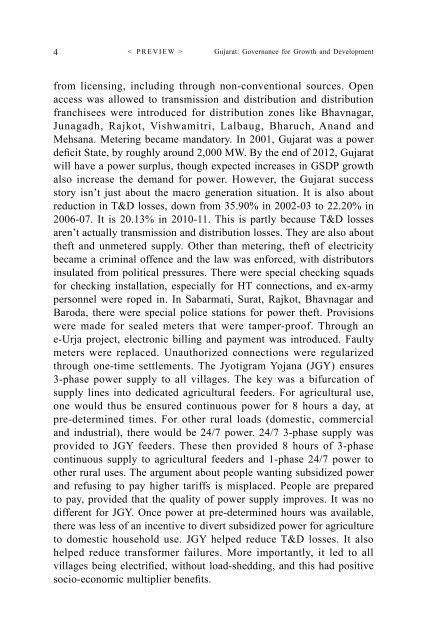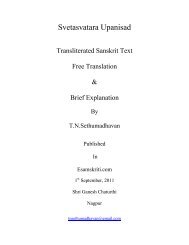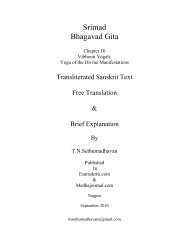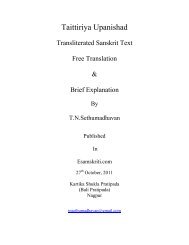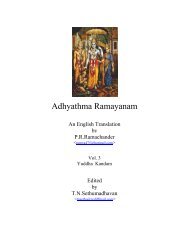Gujarat Governance for Growth and Development ... - Esamskriti.com
Gujarat Governance for Growth and Development ... - Esamskriti.com
Gujarat Governance for Growth and Development ... - Esamskriti.com
You also want an ePaper? Increase the reach of your titles
YUMPU automatically turns print PDFs into web optimized ePapers that Google loves.
4<br />
< PREVIEW > <strong>Gujarat</strong>: <strong>Governance</strong> <strong>for</strong> <strong>Growth</strong> <strong>and</strong> <strong>Development</strong><br />
from licensing, including through non-conventional sources. Open<br />
access was allowed to transmission <strong>and</strong> distribution <strong>and</strong> distribution<br />
franchisees were introduced <strong>for</strong> distribution zones like Bhavnagar,<br />
Junagadh, Rajkot, Vishwamitri, Lalbaug, Bharuch, An<strong>and</strong> <strong>and</strong><br />
Mehsana. Metering became m<strong>and</strong>atory. In 2001, <strong>Gujarat</strong> was a power<br />
deficit State, by roughly around 2,000 MW. By the end of 2012, <strong>Gujarat</strong><br />
will have a power surplus, though expected increases in GSDP growth<br />
also increase the dem<strong>and</strong> <strong>for</strong> power. However, the <strong>Gujarat</strong> success<br />
story isn’t just about the macro generation situation. It is also about<br />
reduction in T&D losses, down from 35.90% in 2002-03 to 22.20% in<br />
2006-07. It is 20.13% in 2010-11. This is partly because T&D losses<br />
aren’t actually transmission <strong>and</strong> distribution losses. They are also about<br />
theft <strong>and</strong> unmetered supply. Other than metering, theft of electricity<br />
became a criminal offence <strong>and</strong> the law was en<strong>for</strong>ced, with distributors<br />
insulated from political pressures. There were special checking squads<br />
<strong>for</strong> checking installation, especially <strong>for</strong> HT connections, <strong>and</strong> ex-army<br />
personnel were roped in. In Sabarmati, Surat, Rajkot, Bhavnagar <strong>and</strong><br />
Baroda, there were special police stations <strong>for</strong> power theft. Provisions<br />
were made <strong>for</strong> sealed meters that were tamper-proof. Through an<br />
e-Urja project, electronic billing <strong>and</strong> payment was introduced. Faulty<br />
meters were replaced. Unauthorized connections were regularized<br />
through one-time settlements. The Jyotigram Yojana (JGY) ensures<br />
3-phase power supply to all villages. The key was a bifurcation of<br />
supply lines into dedicated agricultural feeders. For agricultural use,<br />
one would thus be ensured continuous power <strong>for</strong> 8 hours a day, at<br />
pre-determined times. For other rural loads (domestic, <strong>com</strong>mercial<br />
<strong>and</strong> industrial), there would be 24/7 power. 24/7 3-phase supply was<br />
provided to JGY feeders. These then provided 8 hours of 3-phase<br />
continuous supply to agricultural feeders <strong>and</strong> 1-phase 24/7 power to<br />
other rural uses. The argument about people wanting subsidized power<br />
<strong>and</strong> refusing to pay higher tariffs is misplaced. People are prepared<br />
to pay, provided that the quality of power supply improves. It was no<br />
different <strong>for</strong> JGY. Once power at pre-determined hours was available,<br />
there was less of an incentive to divert subsidized power <strong>for</strong> agriculture<br />
to domestic household use. JGY helped reduce T&D losses. It also<br />
helped reduce trans<strong>for</strong>mer failures. More importantly, it led to all<br />
villages being electrified, without load-shedding, <strong>and</strong> this had positive<br />
socio-economic multiplier benefits.


